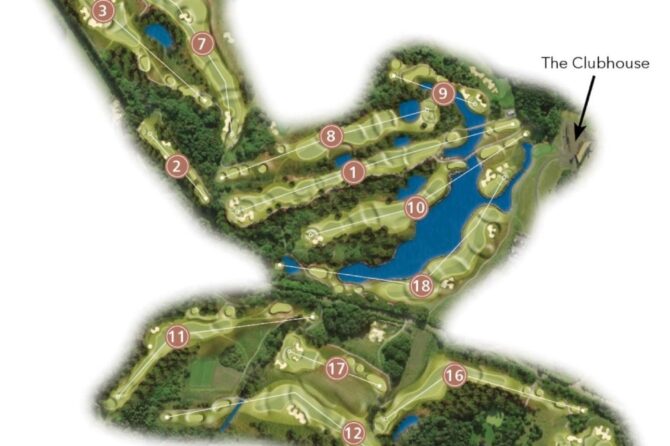Examining Cary Middlecoff’s Techniques: A Scholarly Perspective
The study of golf extends beyond mere athletic prowess; it intertwines art, science, and a rich historical narrative. Among the figures whose contributions have substantially shaped the sport, Cary Middlecoff stands out not only for his competitive achievements but also for his profound impact on golf instruction and technique. Nicknamed ‘Dr. Cary Middlecoff’ due to his background as a dentist, Middlecoff’s dual career exemplifies the fusion of discipline and skill that is critical to success on the golf course. This article seeks to explore Middlecoff’s distinctive techniques and instructional methodologies through a scholarly lens, emphasizing the integration of biomechanics, strategy, and mental fortitude that characterized his approach to golf.
| Technique | Importance |
|---|---|
| Grip | Enhances control and consistency |
| Stance | Provides stability and facilitates swing mechanics |
The Importance of Mental Preparation: Lessons from Cary Middlecoff
Cary Middlecoff’s approach to golf extended far beyond mere physical execution; it emphasized the critical nature of mental preparation. His understanding of the psychological aspects of the game set him apart as a master, illuminating the interplay between mental acuity and performance on the golf course. Middlecoff believed that the mind is both a toolbox and a battleground, where strategic planning and focus serve as precursors to successful shots and round outcomes. To mirror his thought process, players are encouraged to cultivate a routine that prioritizes mental exercise to hone concentration and cultivate resilience.
Middlecoff’s mental preparation techniques can be categorized into several key practices that aspiring golfers can adopt. These include:
- Visualization: Athletes are encouraged to vividly imagine their shots and outcomes, which aids in creating a mental blueprint for success.
- Routine Establishment: Developing a
Furthermore, Middlecoff’s combination of technical proficiency and mental fortitude illustrates that golf is as much a psychological endeavor as it is a physical one. As evidenced by his career achievements, which include three major championships, the mental aspect of his game played a critically important role in his success. By understanding the importance of cognitive strategies, contemporary golfers can draw insights from Middlecoff’s legacy. For instance, the table below summarizes key lessons from his mental preparation methods:
| Technique | Description |
|---|---|
| Visualization | Mental imagery of successful shots |
| Routine Establishment | Consistent actions before each shot |
| Stress Management | Strategies to stay calm under pressure |
Strategic Course Management Techniques in Middlecoff’s Instruction
Cary Middlecoff’s instructional approach to course management is rooted in a profound understanding of not merely the technical skills required for golf but also the strategic mindset that governs successful play. His teachings emphasize the necessity of knowing one’s game intimately, allowing players to make informed decisions that account for both strengths and weaknesses. Middlecoff advocated for an analytical approach to course navigation, suggesting that understanding various course layouts and conditions could significantly influence shot selection and overall scoring.
Among the techniques Middlecoff championed, several key strategies stand out:
- Pre-Round Analysis: He encouraged golfers to study the course before play, identifying potential trouble spots and favorable landing areas.
- Club Selection: Emphasizing the importance of choosing the right club based on conditions, he taught that effective course management hinges upon adapting one’s strategy based on wind, elevation, and other environmental factors.
- Risk Assessment: Middlecoff urged players to weigh the risks of aggressive shots against the likelihood of making a safer play, cultivating an awareness of situational advantages.
To illustrate his course management techniques, a comparative analysis of conventional versus Middlecoff’s approaches can be summarized as follows:
| Traditional Approach | Middlecoff’s Approach |
|---|---|
| Focus on pure technique. | Integrates technique with strategic decision-making. |
| Static club selection based on distance. | Dynamic club selection based on conditions and risk. |
| Surprise and create extraordinary shots. | Maintain consistency through careful planning. |
This systematic approach not only reinforces Middlecoff’s importance as a strategist on the course but also provides a blueprint for players aspiring to elevate their games through enhanced decision-making skills. By integrating technical prowess with tactical insight, Middlecoff’s teachings remain a relevant and invaluable resource for golfers committed to achieving excellence.
Incorporating Short Game Mastery into Your Practice Regimen
Developing a robust short game is essential for any golfer striving for overall enhancement, and Cary Middlecoff’s teachings provide valuable insights into this aspect of the game. Central to Middlecoff’s philosophy is the notion that the short game—comprising chipping, pitching, and putting—accounts for a significant portion of a golfer’s score. To effectively incorporate this mastery into a practice regimen, golfers should prioritize dedicated time for short game drills that focus on precision and consistency. Emphasizing shorter, targeted practice sessions allows golfers to hone their skills more effectively than lengthy, less focused practices.
To emulate Middlecoff’s methodical approach, golfers may consider structuring their practice sessions around specific drills that enhance various short game skills. As a notable example, an effective routine might include:
- Chipping drills: Focus on different lies and distances to improve touch and feel.
- Pitching exercises: Utilize various clubs to become proficient in executing different types of shots.
- Putting practice: Implement distance control and alignment drills to enhance accuracy on the greens.
In line with Middlecoff’s emphasis on mental discipline, a balance of technique and visualization can deepen one’s practice results. By integrating mental imagery when executing short game shots, golfers can develop a clearer sense of what they aim to achieve during actual play. Furthermore, tracking progress through a simple log of successful shots can encourage accountability and motivate golfers to refine their skills over time. This proactive approach to short game mastery is essential for comprehensive growth and lowers scoring averages.
Evaluating the Role of Physical Fitness in Middlecoff’s Golf Philosophy
Cary Middlecoff’s approach to golf extended beyond the fundamentals of swing mechanics and course strategy; it intricately wove physical fitness into the tapestry of his teaching philosophy. Middlecoff recognized that achieving optimal performance on the course required not only technical skill but also a robust physical foundation. His emphasis on fitness was manifested through various aspects of training, which included strength, versatility, and overall conditioning. He posited that golfers who engaged in a dedicated fitness regimen could not only enhance their swing mechanics but also improve their endurance and mental focus throughout a round.
In practical terms, Middlecoff advocated for a balanced fitness routine that could complement a golfer’s natural abilities. His recommendations often included a combination of aerobic exercises, strength training, and flexibility routines, which aimed to promote muscle control and stability during the swing. Furthermore, he highlighted the importance of maintaining a healthy weight and body composition for optimal performance. Many of his contemporaries and later golf instructors adopted this holistic view of fitness, recognizing that physical well-being directly correlated with improved golfing mechanics and reduced injury risk.
The following table illustrates the key areas of focus within Middlecoff’s fitness philosophy, showcasing his commitment to integrating physical fitness into golf training:
| Component | Description |
|---|---|
| Aerobic Conditioning | Enhances endurance and cardiovascular health, enabling golfers to sustain energy throughout longer rounds. |
| Strength Training | Improves muscle power and stability, allowing for a more controlled and powerful swing. |
| Flexibility Exercises | Increases range of motion, crucial for executing fluid and effective swings. |
Thus, Cary Middlecoff’s emphasis on physical fitness transcended the mere enhancement of swing mechanics, laying a foundation for a comprehensive understanding of how holistic well-being and tailored fitness regimens significantly contribute to golfing success. Through his teachings, it becomes clear that the intersection of fitness and golf is vital for aspiring golfers aiming to maximize their potential on the course.
Final Thoughts
The examination of Cary Middlecoff’s golf techniques reveals a multi-faceted approach to the game that extends far beyond mere mechanics. His unique blend of strategic foresight and technical precision not only contributed to his success as a champion but also established a framework for future generations of golfers. By dissecting his methods, we gain invaluable insights into the intricate relationship between body movement, mental acuity, and adaptive learning that characterizes elite performance in golf. As we continue to study and appreciate Middlecoff’s legacy, we are reminded of the timeless nature of his contributions to the sport and the ongoing relevance of his teachings within both amateur and professional contexts. This scholarly perspective not only enriches our understanding of his techniques but also inspires a commitment to lifelong learning and improvement in the pursuit of golfing excellence.





